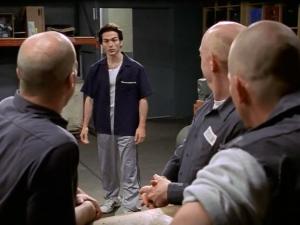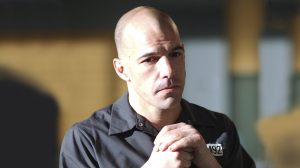“Narrativizing Trauma: Seriality and the Recurring in HBO’s Oz”
Opening Section
At the turn of the century male/male rape (perhaps surprisingly) found sustained representation on television with the debut of Tom Fontana’s prison soap opera Oz on the cable network hbo. Oz (1997-2003) was the first hour-long drama series produced by the Home Box Office, and it would soon be followed by the hit shows The Sopranos (1999-2007), Sex and the City (1998-2004), Six Feet Under (2001-2005), and The Wire (2002-2008), heralding a takeover of “quality” television by non-broadcast networks not subject to fcc regulations that continues with shows such as Game of Thrones (HBO), American Horror Story (FX), House of Cards (Netflix), and Homeland (Showtime). Oz was, in other words, the first in a trend of no-holds-barred television series that were to become the stock in trade of the cable networks and which would soon be representing all manner of sexual activity, nudity (including full-frontal male nudity), graphic violence, drug use, and explicit language, including every one of George Carlin’s famous seven words you can’t say on television. Indeed, Oz already set the bar for shocking content quite high when it debuted in 1997. Over the period of seven years that Oz was on the air, images and explicit discussions of male/male rape were common, even de rigueur on the show. The sexual violation of one male by another, such a taboo topic for discussion in the mid-1960s, was, by the summer of 1997, an almost weekly subject of discourse on cable television.
Because of the medium itself, television’s sustained portrayals of characters for long periods of time allow for – even if they do not always achieve – a much more thorough and complex portrayal of the physical and psychological effects of rape on male victims. This essay, accordingly, turns its attention to the televisual representation of therapy and the discourse of truth in regard to male/male rape, and argues that the very form of the dramatic television series is generically predisposed to treating rape using the psychoanalytic language of trauma and the narrative form of the confession.
When Oz premiered at the late hour of 11:30 pm on 12 July 1997, before settling into its first-season 11:00 pm time slot, it was advertised as a gritty, no-frills examination of day-to-day life in the Oswald maximum-security penitentiary. Although hard-bitten realism is less of a priority for Oz than unusual, sensationalized images of violence and ingenious storytelling the show demonstrates its credibility as a realistic portrayal by featuring rape as a constant occurrence in the fictional prison. In the first two seasons of the show, there is a reference to sexual violation in every episode but one, and over the course of the program’s six seasons (56 episodes) Oz features at least a dozen distinct narratives involving rape, each of which spans multiple episodes. From the first episode, Oz treats rape as a component of prison life and, most importantly, as an event that affects and changes the prisoners in Oswald rather than, as with a film like The Shawshank Redemption (1994), something that can be surmounted or otherwise disavowed. Unique among film and television representations of prison rape, Oz also demonstrates a real interest in the traumatic effects of sexual violence on its victims, paying close attention to the men as they deal with and respond to the violence that they have experienced. I want, in this truncated version of a longer chapter, to make an argument about the development of male/male rape discourse in the latter seasons of Oz, and so I will use only one example from its early seasons, but hopefully this is enough to illustrate the developmental arc I am trying to chart.
In the only rape actually shown onscreen in the first two seasons, Yoruba prisoner Simon Adebisi (Adewale Akinnuoye-Agbaje) rapes his rival drug-dealer, Italian-American Peter Schibetta (Eddie Malavarca). Oz treats Schibetta’s rape as though it is primarily his own responsibility. After Schibetta’s violation, Warden Leo Glynn (Ernie Hudson) and Officer Burrano (Skipp Sudduth) speak in an extraordinarily detached manner about Schibetta as he lies in a hospital bed:
BURRANO. Pancamo and Schibetta were found unconscious, Schibetta’s rectum bleeding; he could’ve been raped.
GLYNN. What do you mean could’ve?
BURRANO. Well, he says he doesn’t know what happened. He won’t talk about it.
GLYNN. Ah, he knows. He’s too ashamed to admit he took one up the ass. He won’t talk; he’ll just get even.
The men do not describe rape as an act of violence done to the victim but rather as something that Schibetta allowed to happen to him (“he took one”). The warden shows no sympathy for the victim, and Fontana does not mitigate this opinion by introducing any of Oz’s other voices.
Later in the episode, it becomes clear that Schibetta has been severely traumatized by the rape. He repeatedly begs Burrano not to tell his (deceased) father about the rape, demonstrating both his mental instability and the shame he feels about having been sexually violated. The rapist Adebisi, on the other hand, struts arrogantly around the prison and is in no way punished for the rape. In fact, the episode reflects without criticism – and therefore reinforces for the show’s audience – the entire structural economy by which rape attains its power in prison. Adebisi gains power by committing rape; Schibetta loses power through having been raped. And neither the show itself nor any character on the show demonstrates any sympathy toward the victim. Schibetta is sent to the psychiatric ward and doesn’t speak another word for the remainder of the second season. In season 3, the Italians, who had been led by Schibetta, partner with Adebisi in order to sell drugs. Their humiliated former leader is forgotten in the psychiatric ward, and he does not appear for the remainder of the season or for any of season 4.
Surprisingly, however, Schibetta returns in season 5…





